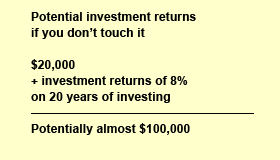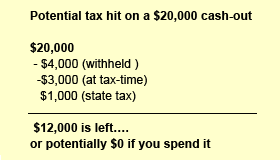
Very often when people leave a job they “cash out” of their vested 401(k) account balances. The better choice is to keep your money working hard for you. Here’s why:
Cashing out doesn’t just mean potentially spending your retirement money. Uncle Sam takes 20% of your hard-earned money off the top and collects more when you file your return.
Let’s assume you’re under age 59 ½, are in the 25% tax bracket, live in a state with a 5% income tax and you “cash out” a balance of $20,000. See below to compare what's left over compared to how much money you might end up with if the amount stayed invested.


Why a Rollover IRA is the best option when you change jobs:
You keep your retirement money working for you and you don’t lose track of it.
The better choice is to set up a rollover IRA at an investment company. While your employer may allow you to leave the money in the plan, if you change jobs often it may be hard to keep track of your retirement savings. Even better, unlike a regular IRA, there’s no limit to how much money can be in a rollover IRA as long as the money started out in a tax-favored plan such as a 401(k).
How to move your money to a Rollover IRA
1. Ask the mutual fund company of your choice for a rollover IRA kit.
2. You can select the mutual fund where the rollover should be invested, ask a financial planner, or consider asking the company to put the money in a lifecycle fund or a balanced fund. Mail in the kit.
3. Complete the employer forms to make a direct rollover or a direct transfer to the IRA. Make sure your employer doesn’t mail you the check; otherwise you may owe taxes.
Please consult our Terms Of Use page before considering any of this advice.


